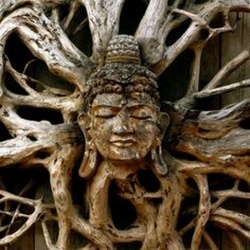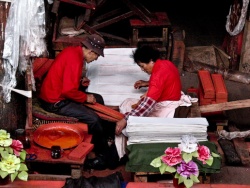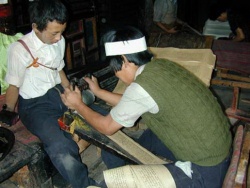Kangyur: The Catalog of Contents
There are a variety of ways to describe how the texts in the Degé Kangyur are organized. One very basic map of the collection can be found in its section titles, which are printed in the margins of the individual volumes. According to these, the Kangyur contains nine sections:
Monastic Conduct (8 titles; D.1-D.8)
Perfection of Wisdom (36 titles, D.9-D.44)
The Flower Ornament Sūtra (1 title; D.45)
The Jewel Heap (49 titles; D.46-D.94)
Sūtras (267 titles; D.95-D.361)
Tantras (472 titles, D.362-D.833)
Ancient Tantras (19 titles; D.834-D.852)
Collected Spells (263 titles, D.854-D.1117)
The Wheel of Time Commentary (1 title, D.853)
However, this simple structure belies the complex doxographical labors that have gone into organizing the Kangyur, for there are numerous subcategories to which its more than 1100 works have been assigned. The outline presented here in the THL Catalog Index is based on the work of Situ Chökyi Jungné (སི་ཏུ་ཆོས་ཀྱི་འབྱུང་གནས་, 1699/1700-1774 CE), editor-in-chief of the Degé Kangyur and author of its principal history and catalog.
Situ’s description of the Kangyur’s organization is in many ways a simple one. As he states at the beginning of his catalog, the Kangyur essentially has only two sections: exoteric scripture (or sūtra) and esoteric scripture (or tantra). Here in the THL Catalog, we have followed these with two additional sections: the “spells” (dhāraṇī) and the commentary on the Wheel of Time Tantra (Kālacakra Tantra). For Situ, however, these latter two are not primary sections of the Kangyur, but are more like appendices. The Collected Spells are a sort of addendum to the tantra section, and the Wheel of Time commentary (which also appears in the Tengyur, where it more properly belongs) is appended to the end of the entire Kangyur, as a statement of this text’s overwhelming importance for the Tibetan tradition.
Within the two primary categories of “Exoteric Scripture” and “Tantra,” Situ classifies the individual texts into further sections and subsections, forming a very detailed nested hierarchy. His basic outline is as follows:
Exoteric Scripture
Monastic Conduct
Perfection of Wisdom
Sūtra Texts Belonging to the Final Turning
The Flower Ornament Sūtra
The Jewel Heap
Greater Vehicle and Lesser Vehicle Sūtras
Tantra (or “Secret Mantra”)
Highest Yoga Tantra
Yoga Tantra
Performance Tantra
Action Tantra
Dedications
Collected Spells
The Wheel of Time Commentary


